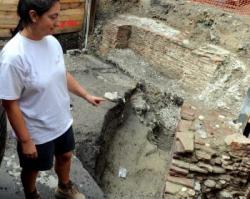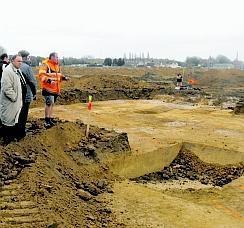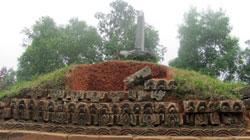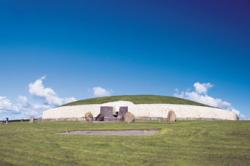10 NOVEMBRE
INDI-UNI : ANTHROPOLOGY - ARCHAEOLOGY
INSCRIPTION 2011 – 2012 COURS A DISTANCE
REGISTRATION 2011 – 2012 ONLINE COURSES
FRANCE –  Toulouse - Une nouvelle campagne de fouilles archéologiques va débuter au cœur de Toulouse à l'occasion du chantier du square du Capitole qui a débuté mi-octobre. Au printemps, les spécialistes de l'Institut national de recherches archéologiques préventives (INRAP) avaient exploré l'angle du square, côté rue du Poids-de-l'Huile, à l'emplacement du futur ascenseur du métro Capitole (notre photo). À partir du 21 novembre, ils vont s'intéresser au centre du square, là où se trouvait la fontaine. Cette campagne devrait durer jusqu'à Noël. Pour les archéologues, c'est une nouvelle fenêtre sur l'histoire de la Ville rose qui va s'ouvrir. Dans les couches sédimentaires, ils devraient trouver des vestiges de bâtiments d'époque romaine, traces du Ier au IVe siècle. Mais aussi des traces de la Toulouse médiévale. Nous sommes ici dans le secteur de la maison commune des Capitouls, siège du pouvoir municipal.
Toulouse - Une nouvelle campagne de fouilles archéologiques va débuter au cœur de Toulouse à l'occasion du chantier du square du Capitole qui a débuté mi-octobre. Au printemps, les spécialistes de l'Institut national de recherches archéologiques préventives (INRAP) avaient exploré l'angle du square, côté rue du Poids-de-l'Huile, à l'emplacement du futur ascenseur du métro Capitole (notre photo). À partir du 21 novembre, ils vont s'intéresser au centre du square, là où se trouvait la fontaine. Cette campagne devrait durer jusqu'à Noël. Pour les archéologues, c'est une nouvelle fenêtre sur l'histoire de la Ville rose qui va s'ouvrir. Dans les couches sédimentaires, ils devraient trouver des vestiges de bâtiments d'époque romaine, traces du Ier au IVe siècle. Mais aussi des traces de la Toulouse médiévale. Nous sommes ici dans le secteur de la maison commune des Capitouls, siège du pouvoir municipal.
http://www.ladepeche.fr/article/2011/11/10/1212746-square-du-capitole-fouilles-le-21-novembre.html
FRANCE –  Haisnes - Le sol d'Haisnes regorge de trésors insoupçonnés. Le service archéologique d'Artois Comm en a eu la confirmation au cours du mois d'octobre. « Nous avons trouvé des traces d'occupation celte et gauloise, puis des objets datant de 14-18», déclare Christophe Manceau, responsable du service. De l'âge de fer au début du XXe siècle, les informations recueillies s'étales sur plus de 2000 ans. Il est de notoriété commune que la terre artésienne conserve encore de nombreuses traces de la Première Guerre mondiale. « Nous sommes en plein sur la deuxième ligne allemande, qui faisait face aux Anglais », note Nicolas Tachet, responsable du chantier. Si les traces laissées par la grande guerre n'étonnent personne, celles de l'époque gallo-romaine ont surpris quelques élus. Un grand silo creusé dans le sol pour conserver des denrées, des morceaux de vases cassés, une partie de la mâchoire d'un boeuf ou encore les traces d'une habitation d'antan « Nous avons trouvé deux silos, des sépultures et des poteries gauloises. Les traces de cette petite exploitation dateraient de la fin de l'époque celte au début de l'aire gallo-romaine. Visiblement, cette habitation a évolué et a été agrandie »,, confient les chercheurs.
Haisnes - Le sol d'Haisnes regorge de trésors insoupçonnés. Le service archéologique d'Artois Comm en a eu la confirmation au cours du mois d'octobre. « Nous avons trouvé des traces d'occupation celte et gauloise, puis des objets datant de 14-18», déclare Christophe Manceau, responsable du service. De l'âge de fer au début du XXe siècle, les informations recueillies s'étales sur plus de 2000 ans. Il est de notoriété commune que la terre artésienne conserve encore de nombreuses traces de la Première Guerre mondiale. « Nous sommes en plein sur la deuxième ligne allemande, qui faisait face aux Anglais », note Nicolas Tachet, responsable du chantier. Si les traces laissées par la grande guerre n'étonnent personne, celles de l'époque gallo-romaine ont surpris quelques élus. Un grand silo creusé dans le sol pour conserver des denrées, des morceaux de vases cassés, une partie de la mâchoire d'un boeuf ou encore les traces d'une habitation d'antan « Nous avons trouvé deux silos, des sépultures et des poteries gauloises. Les traces de cette petite exploitation dateraient de la fin de l'époque celte au début de l'aire gallo-romaine. Visiblement, cette habitation a évolué et a été agrandie »,, confient les chercheurs.
http://www.lavenirdelartois.fr/actualite/Pays_d_Artois/Porte_de_Flandres/2011/11/10/article_haisnes_fouillee_de_fond_en_comble.shtml
USA – Norwich - Aided by 21st-century technology, researchers Wednesday afternoon searched a plot in Yantic Cemetery to determine whether 19th-century anti-slavery activist David Ruggles is buried there. Led by state archaeologist Nicholas Bellantoni, a crew with the U.S. Department of Agriculture used ground-penetrating radar to search a vacant area of the Ruggles family plot. Born in Norwich in 1810, Ruggles is considered the prototype for black activist journalists of his time. His magazine, Mirror of Liberty, is considered the first periodical published by a black American in the United States. According to City Historian Dale Plummer, Ruggles was an important figure in the abolition movement and finding his final resting place is an important move for the city.
http://www.norwichbulletin.com/carousel/x363495015/Burial-plot-scanned-for-remains-of-Norwich-abolitionist#ixzz1dO6BFHBf
USA - Frederick County - An archeologist for a state agency plans to survey Frederick County's industrial enterprise history, and wants the community's help. Iron furnaces, mills and lime kilns fueled the local economy in the Winchester area from the 1700s through the early 20th century. But as those industries ceased operations the sites fell into ruins or vanished as a result of development, according to a news release from the Virginia Department of Historic Resources.
http://www.nvdaily.com/news/2011/11/historic-industrial-sites-to-be-surveyed.php
VIET NAM –  Bac Ninh - The foundation of an 11th-century stone tower has been unearthed at Dam Pagoda in the northern city of Bac Ninh, 30km northeast of Ha Noi, revealing complex features of Buddhist architecture of the period. Located on the southern side of Lam Son Mountain, construction of Dam Pagoda was begun in 1086 under the reign of Ly Nhan Tong and completed in 1094. It was one of the leading examples of Buddhist architecture in the north during the Tran (1225-1400) and Le (1428-1788) dynasties. In the Tran dynasty, the pagoda consisted of 12 buildings while in the Le dynasty, it was expanded to over 100 rooms. According to researcher Le Dinh Phung, who directed the excavation, the foundation formed a square measuring 8.4m by 8.4m. The missing tower was assumed to face east to a height of 1.56m and built with stones decorated in wave patterns. It may have carried Buddha statue on top to face the remaining stone column at the pagoda, Phung said. Upon excavating the foundation and a site of 300sq.m, archaeologists found building materials from the Ly, Tran and Le dynasties and concluded that Dam Pagoda was an architectural complex of four layers covering an area of over 7,500sq.m following the slope of Lam Son Mountain. "This is one of the most intact examples of architecture from the Ly dynasty," said Viet Nam Archaeology Institute director Tong Trung Tin. Luu Tran Tieu, chairman of the National Culture Heritage Council, said the excavation revealed various unique features of the pagoda beside the stone pillar of the pagoda. He proposed further research at the site to gain greater understanding of the architecture of the Ly dynasty.
Bac Ninh - The foundation of an 11th-century stone tower has been unearthed at Dam Pagoda in the northern city of Bac Ninh, 30km northeast of Ha Noi, revealing complex features of Buddhist architecture of the period. Located on the southern side of Lam Son Mountain, construction of Dam Pagoda was begun in 1086 under the reign of Ly Nhan Tong and completed in 1094. It was one of the leading examples of Buddhist architecture in the north during the Tran (1225-1400) and Le (1428-1788) dynasties. In the Tran dynasty, the pagoda consisted of 12 buildings while in the Le dynasty, it was expanded to over 100 rooms. According to researcher Le Dinh Phung, who directed the excavation, the foundation formed a square measuring 8.4m by 8.4m. The missing tower was assumed to face east to a height of 1.56m and built with stones decorated in wave patterns. It may have carried Buddha statue on top to face the remaining stone column at the pagoda, Phung said. Upon excavating the foundation and a site of 300sq.m, archaeologists found building materials from the Ly, Tran and Le dynasties and concluded that Dam Pagoda was an architectural complex of four layers covering an area of over 7,500sq.m following the slope of Lam Son Mountain. "This is one of the most intact examples of architecture from the Ly dynasty," said Viet Nam Archaeology Institute director Tong Trung Tin. Luu Tran Tieu, chairman of the National Culture Heritage Council, said the excavation revealed various unique features of the pagoda beside the stone pillar of the pagoda. He proposed further research at the site to gain greater understanding of the architecture of the Ly dynasty.
http://www.asianewsnet.net/home/news.php?id=23717&sec=10
IRLANDE –  Newgrange - The possibility that Newgrange could have a second passage tomb, which may also be aligned with a solstice event, was being explored by a team of Irish and Slovakians archaeologists using ground-breaking technology. Newgrange is synonymous with sunrise on the winter solstice but the possibility that it has another as yet unknown chamber is not being ruled out. Dr Brady said this week that while the weather conditions encountered by the team at Newgrange created difficulty in the use of the highly-sensitive equipment, it had nevertheless shown that "it works". The purpose of the microgravitational equipment was to detect underground cavities. The microgravity meter responds to variations in density in the ground beneath it.
Newgrange - The possibility that Newgrange could have a second passage tomb, which may also be aligned with a solstice event, was being explored by a team of Irish and Slovakians archaeologists using ground-breaking technology. Newgrange is synonymous with sunrise on the winter solstice but the possibility that it has another as yet unknown chamber is not being ruled out. Dr Brady said this week that while the weather conditions encountered by the team at Newgrange created difficulty in the use of the highly-sensitive equipment, it had nevertheless shown that "it works". The purpose of the microgravitational equipment was to detect underground cavities. The microgravity meter responds to variations in density in the ground beneath it.
http://www.meathchronicle.ie/news/meatheast/articles/2011/11/09/4007577-groundbreaking-technology-shows-no-second-chamber-at-newgrange/